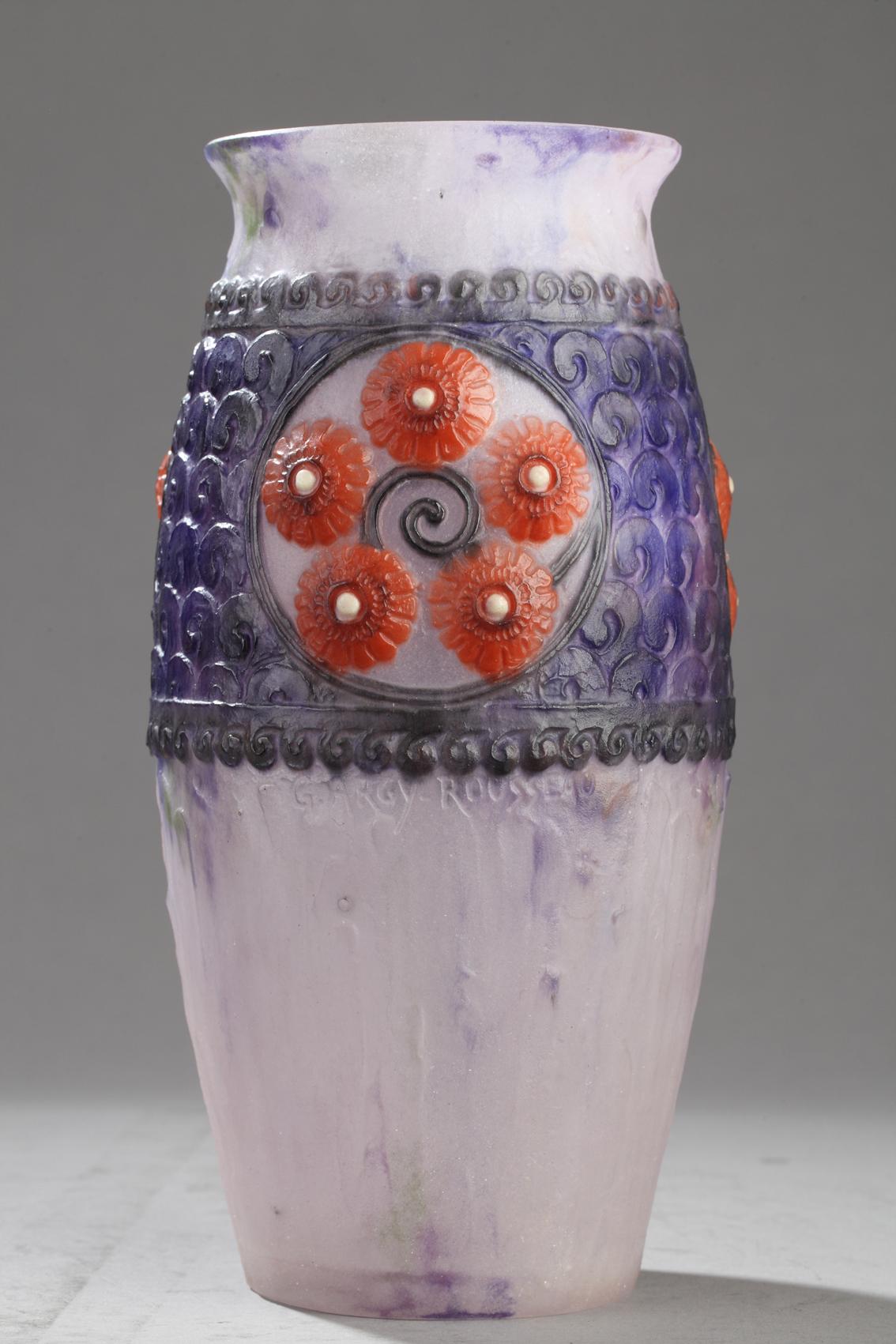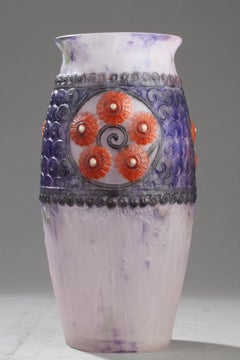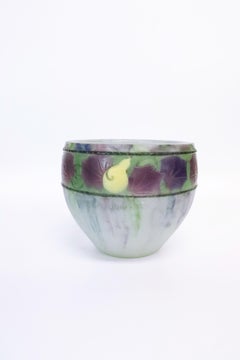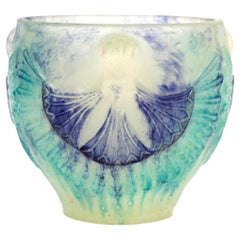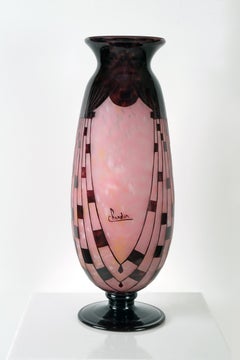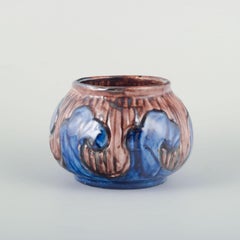Want more images or videos?
Request additional images or videos from the seller
1 of 12
Gabriel Argy-Rousseau"Eagles" footed cup1922
1922
$9,922.57
£7,405.46
€8,300
CA$13,687.45
A$14,971.82
CHF 7,883.07
MX$178,748.23
NOK 100,470.85
SEK 91,906.85
DKK 63,232.35
About the Item
"Eagles" footed cup
by Gabriel ARGY-ROUSSEAU (1885-1953)
Flared glass paste footed cup,
in black, purple, red, and green,
decorated with eagles with spread wings and stylized flowers.
Signed " G. Argy-Rousseau "
Perfect condition
France
circa 1922
height 9,5 cm
diameter 16 cm
Model presented in 1922, reproduced in "Les pâtes de verre, catalogue raisonné G. Argy-Rousseau", Les éditions de l'amateur, p.189.
Biography :
Joseph Gabriel Rousseau called Gabriel Argy-Rousseau (1885-1953) was a French sculptor, ceramist and glassmaker who contributed to the rediscovery of cameo glass as a major glass art of the early twentieth century. If the technique of cameo glass dates back to ancient times, it fell into oblivion for a long time. In the last quarter of the nineteenth century, Henri Cros and a handful of artists, often ceramists of the Art Nouveau movement, such as François Décorchemont or Georges Despret, put it in the spotlight. The last of these precursors was Gabriel Argy-Rousseau. He was considered as the only glassmaker to have developed and used the complex process of cameo glass, the other glassmakers working with crystal paste.
Entering the Ceramics School of Sèvres, he discovered the cameo glass in the workshop of Henri Cros. Gabriel Argy-Rousseau began to produce between 1910 and 1920. His early works were influenced by Art Nouveau style plant motifs and animal themes. He began at the 1914 Salon of the French Artists in Paris. Between 1921 and 1931, established rue Simplon in Paris, he was a shareholder in the Argy-Rousseau cameo Glass Society. With many collaborators, he produced small very colorful Art Nouveau and Art Deco subjects, distributed in small series: pendants, vases, lamps and night lights and, from 1928, sculptures (statuettes or bas-reliefs) in collaboration with Marcel Bouraine. Unlike his fellow ceramicists, he remained belatedly faithful to the polychrome effects and floral motifs of Art Nouveau style. He developed shimmering colors (ruby red, amethyst, gray, deep blue ...) and textures with marbled effects. He invented new processes for the superficial coloring of the paste, by painting oxide powder before second firing at a low temperature. His works were in glass paste, the statuettes usually in crystal paste.
The glass creations of Gabriel Argy-Rousseau remain among the most typical and representative examples of Art Deco production. The production of the workshop ceased in 1931, but Argy-Rousseau continued to create pieces of crystal paste, because of the economic crisis, the opportunity to work the expensive process of the glass paste was no longer possible. He exhibited punctually, especially in 1934, glassware adorned with precious metals. His last exhibition took place a year before his death in 1952. He died forgotten, but left many works in the glass branch, now rediscovered.
Joseph Gabriel Rousseau called Gabriel Argy-Rousseau (1885-1953) was a French sculptor, ceramist and glassmaker who contributed to the rediscovery of cameo glass as a major glass art of the early twentieth century. If the technique of cameo glass dates back to ancient times, it fell into oblivion for a long time. In the last quarter of the nineteenth century, Henri Cros and a handful of artists, often ceramists of the Art Nouveau movement, such as François Décorchemont or Georges Despret, put it in the spotlight. The last of these precursors was Gabriel Argy-Rousseau. He was considered as the only glassmaker to have developed and used the complex process of cameo glass, the other glassmakers working with crystal paste. Entering the Ceramics School of Sèvres, he discovered the cameo glass in the workshop of Henri Cros. Gabriel Argy-Rousseau began to produce between 1910 and 1920. His early works were influenced by Art Nouveau style plant motifs and animal themes. He began at the 1914 Salon of the French Artists in Paris. Between 1921 and 1931, established rue Simplon in Paris, he was a shareholder in the Argy-Rousseau cameo Glass Society. With many collaborators, he produced small very colorful Art Nouveau and Art Deco subjects, distributed in small series: pendants, vases, lamps and night lights and, from 1928, sculptures (statuettes or bas-reliefs) in collaboration with Marcel Bouraine. Unlike his fellow ceramicists, he remained belatedly faithful to the polychrome effects and floral motifs of Art Nouveau style. He developed shimmering colors (ruby red, amethyst, gray, deep blue ...) and textures with marbled effects. He invented new processes for the superficial coloring of the paste, by painting oxide powder before second firing at a low temperature. His works were in glass paste, the statuettes usually in crystal paste. The glass creations of Gabriel Argy-Rousseau remain among the most typical and representative examples of Art Deco production. The production of the workshop ceased in 1931, but Argy-Rousseau continued to create pieces of crystal paste, because of the economic crisis, the opportunity to work the expensive process of the glass paste was no longer possible. He exhibited punctually, especially in 1934, glassware adorned with precious metals. His last exhibition took place a year before his death in 1952. He died forgotten, but left many works in the glass branch, now rediscovered.

About the Seller
5.0
Recognized Seller
These prestigious sellers are industry leaders and represent the highest echelon for item quality and design.
Established in 1992
1stDibs seller since 2023
11 sales on 1stDibs
Typical response time: 1 hour
- ShippingRetrieving quote...Shipping from: PARIS, France
- Return Policy
More From This Seller
View AllBowl "Nature"
By Émile Gallé
Located in PARIS, FR
Bowl "Nature"
by Emile GALLE (1846-1904)
Exceptional bowl in multi-layered blown-molded glass,
decorated in interlayer with metal oxydes and powders.
Ornated with a glass marquetry,...
Category
Early 1900s Art Nouveau More Art
Materials
Blown Glass
A "Tristesse" vase
By Émile Gallé
Located in PARIS, FR
A "Tristesse" vase
by Émile Gallé (1846-1904)
An exceptional and extremely rare vase known as "Vase de tristesse" ("Vase of Sadness"),
raised on a molded foot.
Made of double-layere...
Category
1880s Art Nouveau More Art
Materials
Blown Glass
Vase known as "Tragi-comic"
Located in PARIS, FR
Vase known as "Tragi-comic"
by Gabriel ARGY-ROUSSEAU (1885-1953)
A pyriform flaring neck vase made in cameo glass (pâte de verre),
ornated with a frieze of Ancient theater tragic an...
Category
1920s Art Deco More Art
Materials
Glass
Vase with Flowery medallions
Located in PARIS, FR
Vase known as "Flowery medallions"
Gabriel ARGY-ROUSSEAU (1885-1953)
Made in cameo glass (pâte de verre),
ornated with a wide violet-blue wave motif frieze,
adorned with three red-c...
Category
1920s Art Deco More Art
Materials
Glass
Bowl "Marquetry with Crocus"
By Émile Gallé
Located in PARIS, FR
Bowl "Marquetry with Crocus"
by Emile GALLE (1846-1904)
An elongated form bowl,
with hot-applied handles.
Multi-layered blown-molded glass,
with an inlaid decor of purple and orang...
Category
1890s Art Nouveau More Art
Materials
Blown Glass
Vase "Erable plane"
By Émile Gallé
Located in PARIS, FR
"Norway maple" Vase
by Émile GALLE (1846-1904)
Rare baluster-shaped vase,
multi-layered glass with powder and gold foil inclusions.
Wheel-carved cameo decoration,
ornated with mapl...
Category
Early 1900s Art Nouveau More Art
Materials
Blown Glass
You May Also Like
Courde (Gourd) Bowl
Located in Missouri, MO
Gabriel Argy-Rousseau (1885-1953)
Gourds Bowl c. 1922
Glass
Signed
3.75 x 4.5 inches
This G. Argy-Rousseau bowl has a very distinct arts and crafts feel...
Category
Early 20th Century Art Deco More Art
Materials
Glass
1924 Gabriel Argy-Rousseau Bowl Lotus Pate de Verre Glass
By Gabriel Argy-Rousseau
Located in Boulogne Billancourt, FR
Bowl "Lotus" made in white, green and blue pate de verre glass by Gabriel Argy-Rousseau in 1924.
Molded signature.
Perfect condition - some air bubbles as usual in this model
Exc...
Category
Vintage 1920s French Art Deco Vases
Materials
Blown Glass
La Verre Francais
By Charles Schneider
Located in Miami, FL
Le Verre Francais
Charder Collection.
Signed "Charder" on one of the sides of the vase and "Le Verre Francais" on the base.
Similar works are published in the book "Charles Schneider: La Verre...
Category
1920s Art Deco More Art
Materials
Glass
Small ceramic vase, attributed to Møller & Bøgely. Approx. 1918–1922.
Located in København, Copenhagen
Attributed to Møller & Bøgely, small stoneware vase.
Made around 1918–1922.
The vase is decorated with a relief pattern and glaze in shades of brown and deep blue with lively surfa...
Category
Vintage 1910s Danish Art Nouveau Vases
Materials
Stoneware
Art Nouveau Egyptian Sphinx Bowl by Ernst-Wahliss c. 1900
Located in Chicago, IL
Unique earthenware bowl featuring a pair of golden Egyptian sphinxes and stylized purple flowers in an incised pattern, with an iridescent glaze of rich green, blue, and purple hues....
Category
1910s Art Nouveau More Art
Materials
Ceramic
Monumental Wedgwood Ordinary Lustre Footed Bowl By Daisy Making-Jones
By Daisy Makeig-Jones
Located in Rothley, Leicestershire
Imposing and monumental Wedgwood footed bowl by Daisy Makes-Jones of the Ordinary Lustre Series
Superbly vibrant blue mottled ground decorated wi...
Category
Early 20th Century British Art Deco Decorative Bowls
Materials
Porcelain

